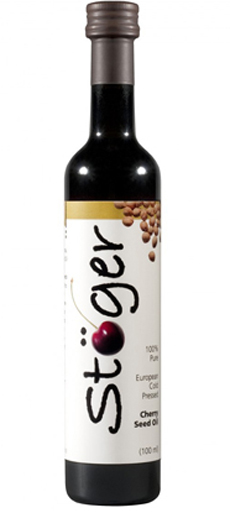TIP OF THE DAY: Pressed Seed Oils
|
Chef Johnny Gnall ventured beyond sesame seed oil to try other oils pressed from seeds. He discovered several lines from Austria and Slovenia, and his suggestions follow. If you have questions or suggestions for tips, email Chef Johnny. Among the various trending food products at a recent trade show, seeds and oils seemed to be particularly popular items. Both are hailed for their health benefits as well as their versatility; they can be folded into a recipe for a subtle note or used to finish it for a more up-front salutation to flavor. Only pumpkin seed oil seems to have created a presence among American foodies. But I had the opportunity to sample a larger selection of gourmet pressed seed oils, from Stoger (pronounced SHTOO-ger), a family farm in Neuruppersdorf, Austria. The seeds are slowly roasted and cold pressed in a 100% natural process. There’s no fruit flesh in these oils—just the seeds of the fruit. The result is a particularly vibrant color and a distinct flavor that you will not find in infused oils (where the flesh is infused in olive oil to flavor it). As with infused oils, each seed’s oil tastes of the fruit into which it would have grown, but in a way you’ve never experienced before, slick and satisfying as it lingers on your palate. Stöger makes four varieties of seed oil: cherry, chile, pumpkin and tomato. They’re a boon to cooks looking for flavorful new ingredients. A few suggestions for each oil follow; you can buy them from Culinary-Imports.com. |
Cherry seed oil: a new and exciting ingredient for American cooks. Photo courtesy Culinary imports. |
|
|
Cherry Seed Oil Definitely packing the most flavor of the four oils, the cherry seed oil had me in love before I even tasted it. Its mild, pleasant aroma is floral and beguiling. It smells deliciously “pink,” although I realize how strange that sounds. The cherry flavor is round and prominent, but its delivery is different from any cherry product you’ve ever tried. I would recommend this oil on almost anything sweet, from vanilla ice cream, to granola, to a piece of fruit that may need dressing up. You could also add a small amount to a salad dressing (to complement the olive oil or other oil), or to some whipped cream for a bold, sweet take on dessert topping. The brilliant red color of the oil adds a visual pop to anything it hits. Drizzle it over cheese, bread or chocolate: It’s a great “secret ingredient.” |
||
 Tomato seed oil from Weingut Umathum, another Austrian producer. Photo courtesy Weingut Umathum. |
Chile Seed Oil
Chile seed oil packs a kick, but in quite a manageable way: The heat from the chile stays on the tip of your tongue, as opposed to taking over your whole mouth, and the fat in the oil helps to tame some of the fire. (The importer wrote that it’s “devilishly hot, but in an angelic way.”) If you try it plain, you may think that chile oil tastes distinctly like buffalo wings, but without the saltiness or tanginess. For this reason, I recommend it drizzled over grilled chicken, or any chicken for that matter. It’s also a great way to add a controllable heat to dressings and marinades, when adding the entire chile or its seeds might make things a bit too fiery. Add a couple of drops to pasta sauce, appetizer spreads, as a soup garnish or—surprise!—drizzled over chocolate ice cream. For a quick snack, you can sprinkle chile seed oil over nuts or popcorn…but make sure to have an ice-cold beer nearby, just in case! Nutty and earthy, this pumpkin oil delivers subtle flavor notes and hints before the pumpkin flavor sets in. This is the most savory of the oils, and is a hit drizzled over squash risotto or pumpkin soup. Using the oil in conjunction with actual pumpkin or other squash will give you a nice contrast of different flavors, depending on how you cook your gourd. The oil is heavy in nuttiness but not really sweet, so try roasting the squash to get some sweet caramelization, then hit it with a few drops of pumpkin oil to bring out the full spectrum of the pumpkin. This dark green gourmet oil is also delicious in dressings, over potatoes of any kind and yes, drizzled over vanilla ice cream. Try adding some salt and pepper to the oil as a bread dipper, or drizzle it into an avocado. And you thought it was all about the pie! |
|
|
Tomato Seed Oil The mildest of the four oils, delivering a flavor reminiscent of sun-dried tomatoes, surprised me a great deal: Rarely do you experience tomato flavor without a hit of sweetness and/or acidity. Try drizzling tomato seed oil over garlic bread for a flavor reminiscent of marinara but still distinctly different from it. Use it in summery vinaigrettes, whether or not the salad you’re dressing has tomatoes. A few drops in a grilled cheese sandwich will add an unexpected but very complimentary a layer of flavor (it’s always fun to class up comfort foods). Use this exotic oil for finishing pasta dishes or as a cheese condiment, drizzled over cheese. It makes a delicious bread dipping sauce: Just add cracked pepper and grated Parmesan cheese. FIND MORE OF OUR FAVORITE GOURMET OILS & RECIPES.
|
||



